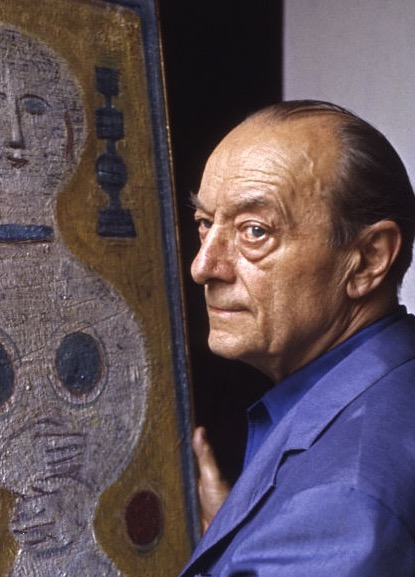
Massimo Campigli
Massimo Campigli was an influential Italian painter and journalist.
Biography of Massimo Campigli
Born in Berlin in 1895 as Max Ihlenfeld, Massimo Campigli spent most of his childhood in Florence before the family relocated to Milan. He worked for the Letteratura magazine, and he was published by the Futurist magazine Lacerba in 1914 in Milan. Captured during World War I, he was imprisoned in Hungary from 1916–18.
Post-war, Campigli worked as a foreign correspondent for Corriere Della Sera, which sent him to Paris, and he worked for them from 1919 to 1928 until he married. He frequented the Café du Dôme, meeting artists like Giorgio de Chirico and Gino Severini. He began painting in Paris, initially creating figurative works influenced by the classical 1920s works of Picasso and Léger's Cubism. In 1923, his first solo exhibition took place at the Galleria Bragaglia in Rome.
By the mid-1920s, his art shifted to monumental figures in near-symmetrical compositions, reminiscent of Le Corbusier's Purism. In 1927, he left his job with Corriere to focus solely on painting. Extended visits to the Louvre fueled his interest in ancient Egyptian art, a lasting source of inspiration.
In 1929, the Galerie Jeanne Bucher hosted an exhibition that featured artworks by Campigli, depicting women with wasp-like waists reminiscent of archaic statuettes. The pieces displayed isolated figures with plaster-like colors, and the heavy emphasis on the contrast between heavily worked areas and lightly sketched backgrounds showed Campigli's connections with the art of the antique world. The following year, the artist was commissioned to produce five prints for Virgil's Georgics, which increased his renown. He had the opportunity to showcase his works in four different exhibitions across New York, Berlin, Zurich, Amsterdam, and Bern alongside the Novecento group.
In 1933, before he departed from Paris to Italy, the artist signed the Manifesto della pittura murale alongside Mario Sironi, Carlo Carrà, and Achille Funi. This marked the beginning of a successful period in his career as a muralist. Notable among his public commissions were those for Milan’s Palazzo di Giustizia, the University of Padua, and the Italian Exhibition Pavilion in New York. The artist also created a fresco portraying mothers, country women, and working women for the V Milan Triennial, which was later destroyed.
At the onset of World War II, the artist decided to leave Paris and relocate to Venice, where he began to focus more on his literary graphic works. His artistic career flourished, partly due to his collaboration with Piero Fornasetti, who printed his lithographs. In 1948, the last collaboration with Fornasetti was to create lithographs for André Gide's Theseus. The book was published the following year by Giovanni Mardersteig's Officina Bodoni.
Following the Second World War, the artist returned to Paris but eventually relocated to Rome in 1951 before permanently settling in St. Tropez in 1963. In the 1960s, Campigli's artistic oeuvre primarily centered on the creation of multi-hued markings on nearly abstract canvases. Notably, in 1967, a retrospective exhibition was held at the Palazzo Reale in Milan, dedicated to showcasing the artist's prolific and influential career.
Massimo Campigli passed away in Saint-Tropez in 1971.
Years:
Born in 1895
Country:
Germany, Berlin
Gallery: